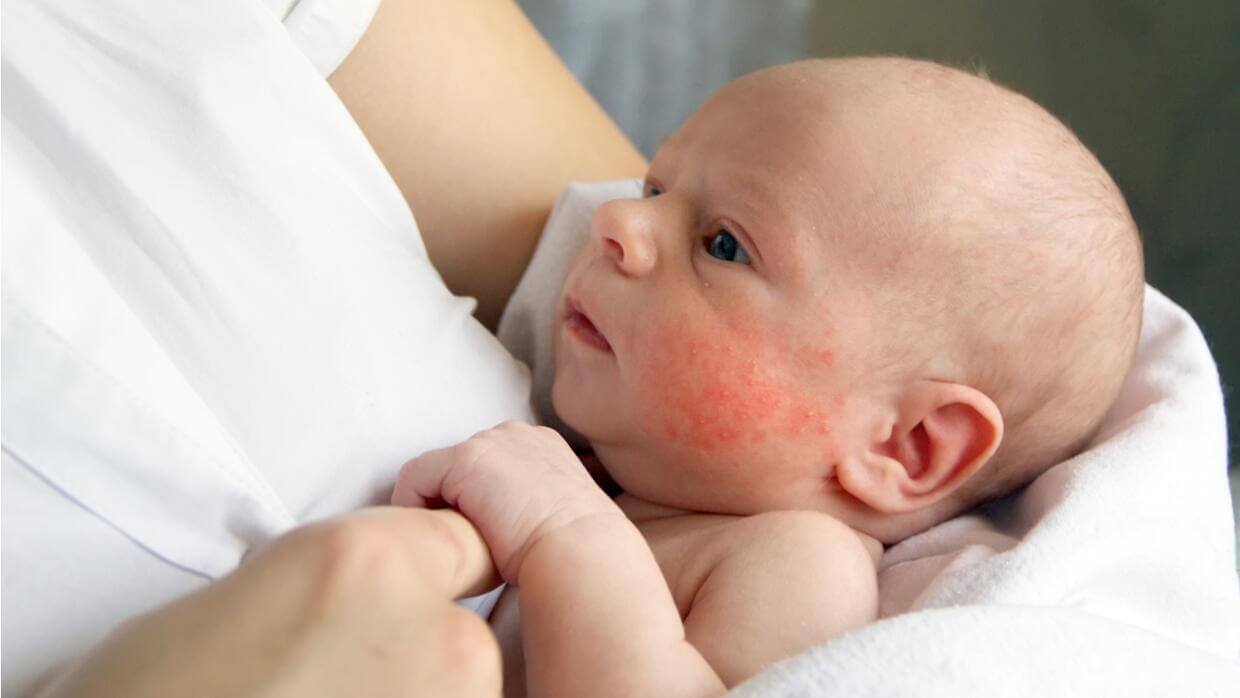Angel Kisses and Stork Bites: All About These Red Spots on Babies


Written and verified by the dermatologist Maria del Carmen Hernandez
The most common spots in newborn babies are “angel kisses” and “stork bites”. Both are red in color, benign, and, in most cases, resolve on their own over time. There are characteristics that allow us to differentiate and recognize each one of them. Therefore, here’s everything you need to know about these spots.
What are vascular birthmarks?
Birthmarks can appear from birth or during the infant’s first month of life. They occur in 40% of newborns.
The patches can be red or pink and most commonly occur on the eyelids, between the eyes, or on the back of the neck, according to publications in Actas Dermo-Sifiliograficas. In addition, there are differences between birthmarks. In fact, some are tiny and difficult to perceive, while others are larger and more noticeable. In general, they don’t require treatment by a dermatologist.

Angel kisses in babies
This name comes from the belief that they were caused by the kiss of an angel on the forehead of babies at the moment of birth, as a gesture of blessing. This is why angel kisses are salmon-colored spots that are most often located on the eyelids and forehead. There are also other names such as nevus flammeus, salmon spots, simple nevus, or flat angioma.
You may be interested in: How to Avoid Skin Irritation in Babies?
Stork bites
Birthmarks called stork bites are the most common. They manifest themselves in 30 to 50% of infants with a characteristic flat, pink appearance. In addition, they’re generated when the blood vessels under the skin dilate or stretch. Unlike the angel’s kiss, it usually takes longer to disappear or may not even disappear completely.
Its name is due to the stories that tell that the stork causes this spot when carrying babies along with their parents. For this reason, its most frequent location is in the region of the nape of the neck. The vast majority of birthmarks become more noticeable and evident when the baby cries, strains to defecate, or if there is a change in the temperature of the environment.
Do angel kisses and stork bites require treatment?
These types of birthmarks are benign spots on the skin of newborns, so they do not require medical treatment. In addition, the appearance of babies is in constant transformation as the skin thickens and matures. Therefore, angel kisses and stork bite marks may appear less obvious or disappear altogether as the child grows and develops.
However, there are cases where they linger, so some people turn to therapeutic options such as lasers to remove them. This is a painless and effective treatment, but usually requires several sessions to obtain the desired result.
Read also: 7 Things You Didn’t Know About Babies’ Skin

Is a visit to the doctor necessary?
Although salmon-colored birthmarks are benign and tend to disappear spontaneously, they should be distinguished from infantile hemangiomas and port wine stains, which require other therapeutic management and follow-up. Angel kisses and stork bites don’t require any extra personal care. The skin should only be treated with gentle cleansing and careful moisturizing.
The use of home remedies isn’t recommended, such as the application of certain products or creams that aren’t indicated by a professional. It’s best to contact a pediatrician only if the skin bleeds, if cracks are generated, or if the area becomes darker or raised.
Don’t panic
It’s normal for parents to have concerns or doubts about birthmarks that appear on the skin of newborn babies. Ideally, don’t panic or think that the mark was caused by some unknown trauma. On the contrary, you should always consult your pediatrician, who’ll be the person qualified to answer all your questions and indicate how to handle and care for your little one.
The most common spots in newborn babies are “angel kisses” and “stork bites”. Both are red in color, benign, and, in most cases, resolve on their own over time. There are characteristics that allow us to differentiate and recognize each one of them. Therefore, here’s everything you need to know about these spots.
What are vascular birthmarks?
Birthmarks can appear from birth or during the infant’s first month of life. They occur in 40% of newborns.
The patches can be red or pink and most commonly occur on the eyelids, between the eyes, or on the back of the neck, according to publications in Actas Dermo-Sifiliograficas. In addition, there are differences between birthmarks. In fact, some are tiny and difficult to perceive, while others are larger and more noticeable. In general, they don’t require treatment by a dermatologist.

Angel kisses in babies
This name comes from the belief that they were caused by the kiss of an angel on the forehead of babies at the moment of birth, as a gesture of blessing. This is why angel kisses are salmon-colored spots that are most often located on the eyelids and forehead. There are also other names such as nevus flammeus, salmon spots, simple nevus, or flat angioma.
You may be interested in: How to Avoid Skin Irritation in Babies?
Stork bites
Birthmarks called stork bites are the most common. They manifest themselves in 30 to 50% of infants with a characteristic flat, pink appearance. In addition, they’re generated when the blood vessels under the skin dilate or stretch. Unlike the angel’s kiss, it usually takes longer to disappear or may not even disappear completely.
Its name is due to the stories that tell that the stork causes this spot when carrying babies along with their parents. For this reason, its most frequent location is in the region of the nape of the neck. The vast majority of birthmarks become more noticeable and evident when the baby cries, strains to defecate, or if there is a change in the temperature of the environment.
Do angel kisses and stork bites require treatment?
These types of birthmarks are benign spots on the skin of newborns, so they do not require medical treatment. In addition, the appearance of babies is in constant transformation as the skin thickens and matures. Therefore, angel kisses and stork bite marks may appear less obvious or disappear altogether as the child grows and develops.
However, there are cases where they linger, so some people turn to therapeutic options such as lasers to remove them. This is a painless and effective treatment, but usually requires several sessions to obtain the desired result.
Read also: 7 Things You Didn’t Know About Babies’ Skin

Is a visit to the doctor necessary?
Although salmon-colored birthmarks are benign and tend to disappear spontaneously, they should be distinguished from infantile hemangiomas and port wine stains, which require other therapeutic management and follow-up. Angel kisses and stork bites don’t require any extra personal care. The skin should only be treated with gentle cleansing and careful moisturizing.
The use of home remedies isn’t recommended, such as the application of certain products or creams that aren’t indicated by a professional. It’s best to contact a pediatrician only if the skin bleeds, if cracks are generated, or if the area becomes darker or raised.
Don’t panic
It’s normal for parents to have concerns or doubts about birthmarks that appear on the skin of newborn babies. Ideally, don’t panic or think that the mark was caused by some unknown trauma. On the contrary, you should always consult your pediatrician, who’ll be the person qualified to answer all your questions and indicate how to handle and care for your little one.
All cited sources were thoroughly reviewed by our team to ensure their quality, reliability, currency, and validity. The bibliography of this article was considered reliable and of academic or scientific accuracy.
- Pocock, Ben et al. “Molecular Basis of Vascular Birthmarks.” Seminars in Plastic Surgery vol. 20,3 (2006): 149–156. doi:10.1055/s-2006-949116
- Leung AK, Telmesani AM. Salmon patches in Caucasian children. Pediatr Dermatol. 1989 Sep;6(3):185-7. doi: 10.1111/j.1525-1470.1989.tb00813.x. PMID: 2798254.
- Monteagudo B, Labandeira J, Acevedo A, Cabanillas M, León-Muiños E, Fernández-Prieto R, Toribio J. Mancha salmón: estudio descriptivo [Salmon patch: a descriptive study]. Actas Dermosifiliogr. 2011 Jan;102(1):24-7. Spanish. doi: 10.1016/j.ad.2010.06.019. Epub 2010 Dec 22. PMID: 21315858.
This text is provided for informational purposes only and does not replace consultation with a professional. If in doubt, consult your specialist.








